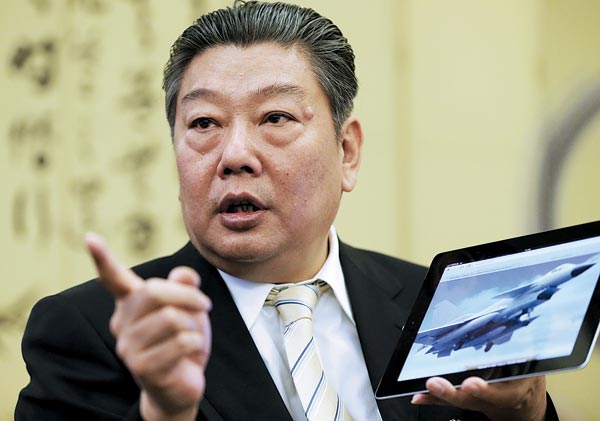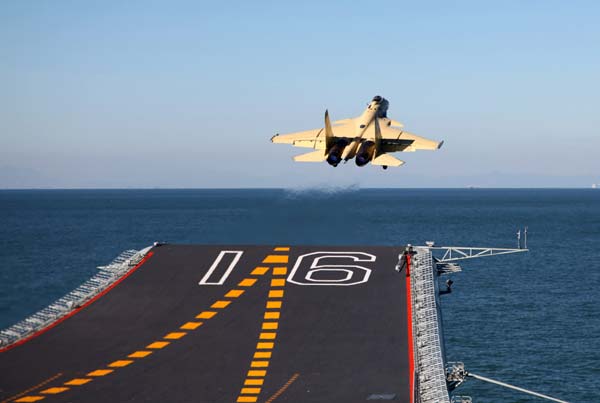|
 Lin Zuoming, chairman of Aviation Industry Corp of China, says reliable and high-performance engines for passenger aircraft are the company's goal.[Xu Jingxing / China Daily]
|
The company that produced fighters for China's first aircraft carrier, which conducted successful flight tests, said it was aiming to test fly passenger-aircraft engines by 2015.
Deck landings were carried out on the carrier with the new J-15 fighter jet, naval sources said on Sunday. But the focus is also on passenger aircraft.
"We are going all out to resolve the bottleneck in the country's rapidly growing aviation industry — reliable and high-performance engines for passenger aircraft," Lin Zuoming, chairman of Aviation Industry Corp of China, told China Daily.
The group, with at least 500,000 employees, has just produced the first prototype of a high-bypass turbofan engine for large commercial aircraft. But it may take "years", and numerous tests, before it soars into the sky, he said.
Lin, 55, made the remarks on the sidelines of the 18th National Congress of the Communist Party of China this month.
He was elected to the 205-member Central Committee of the CPC.
Lin's company, listed in the Fortune Global 500, manufactures aircraft for the Liaoning, the country's first aircraft carrier, refitted from the Soviet Union's Varyag warship. The Liaoning was commissioned in September.
Jet fighters previously practiced "touch and go" exercises, according to earlier media reports.
The J-15 fighter that was used in the deck landing "is able to carry multitype antiship, air-to-air and air-to-ground missiles, as well as precision-guided bombs", the Xinhua News Agency reported.
"We have produced reliable engines for military aircraft and we must also design and develop reliable, high-performance engines for passenger planes," Lin, one of the country's leading engine scientists, said.
 |
|
A J-15 fighter jet takes off from the Liaoning as China's first aircraft carrier conducts successful deck-landing exercises. [Photo/China Daily] More photos |
China's second stealth fighter prototype, which military enthusiasts and bloggers dubbed J-31, conducted its maiden flight in October and made headlines in the media and on the Web.
"In many ways, it is not inferior to the US F-35," said Lin. "If fitted with either of the two types of our newly-developed engines, it will be more advanced than the US model."
There has been speculation on the Web that the J-31 appears to be designed for an aircraft carrier that uses catapult stroke technology on its flight deck.
Military enthusiasts noted that J-31 has landing gear that is tailored for such takeoffs even though the Liaoning uses ski-jump takeoffs.
Lin declined to comment on the speculation. But he said the aircraft carrier project augured well for the aviation sector since it means the industry will produce various types of aircraft, including fighters, helicopters and trainers, for carriers.
Lin said China's rapidly expanding aviation sector is waiting for state-of-the-art engine technology. Only a handful of countries have mastered this technology.
The country will need an additional 5,260 large passenger aircraft and demand for business jets will reach 2,400 aircraft by 2031, according to forecasts by aircraft manufacturers Boeing and Bombardier.
With each aircraft requiring at least two engines plus spares, total demand could reach 16,000 engines, Reuters reported on Oct 30.
Lin, whose conglomerate is the major manufacturer of military and commercial planes in China, envisaged Chinese aircraft will one day be able to choose different engines from a range of options.
Zhang Jian, vice-president of AVIC Aviation Engine Holding Co Ltd, said the company had launched a special engine R&D program to catch up with advanced international standards, Xinhua reported on Oct 14.
"We estimate the accumulative investment nationwide in the short run will pass 100 billion yuan ($15.8 billion)," the report quoted Zhang as saying at the China International Aviation & Aerospace Exhibition in Zhuhai, Guangdong province this month.
Lin said earlier that the AVIC had set aside 10 billion yuan of its own funds for a five-year engine development project.
He said the country's aviation industry is endowed with high-caliber young talent and professionals with passion to aim high.
"For us, being dedicated to the aviation industry is a way to dedicate ourselves to the renaissance of our nation," Lin said.
A native of Zhangzhou, Fujian province that faces the island of Taiwan, Lin developed a keen interest in aircraft in childhood. He was riveted by fighter jets taking off and landing at a base in his hometown. And 2012 marks his 30th year in the industry.
AVIC, with 200 subsidiaries including 26 listed companies, has taken "great strides" in terms of technical upgrading and innovation over the past decade, increasingly closing the gap with established global aircraft manufacturers, he said.
For example, it took 18 years for AVIC to develop the J-10, an advanced third-generation fighter jet, which was delivered in 2004.
But when demand for high-altitude helicopters arose following the devastating Wenchuan earthquake in southwest China's Sichuan province in 2008, the company developed the AC313, a 13-ton helicopter, in just four years.
Next year, AVIC will begin to develop high-altitude helicopters able to carry twice the payload of the AC313, he added.
Contact the writer at zhaohuanxin@chinadaily.com.cn
